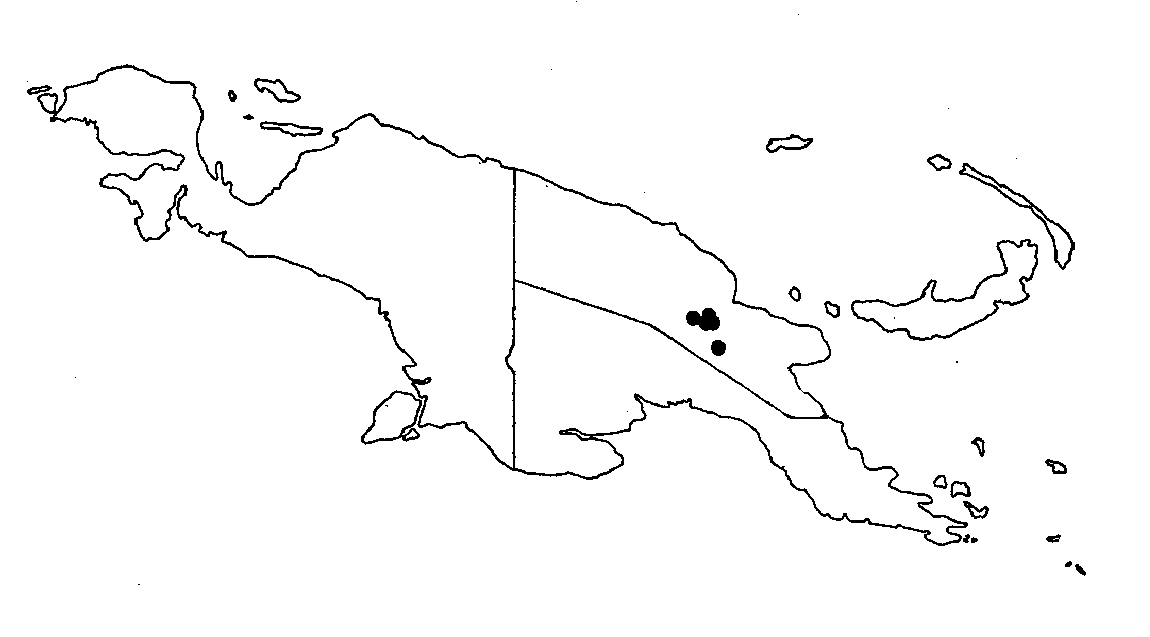
Distribution Map

Description (Barlow 1992)
Amyema dilatipes Barlow, Austral. J. Bot. 22 (1974) 575. - Type: Brass 30053 (holo L 961,157190; iso CANB 101990, K), New Guinea, E Highlands, Mt Wilhelm, E slopes, 3560 m, 20.vi. 1959.
For description see Barlow, Austral. J. Bot. 22 (1974) 575. The species is distinctive in its combination of ternate or quaternate leaves on triangular or quadrangular stems, long inflorescence peduncle dilated at the apex, with many rays, flowers in tetrads, and forked bracts. The flower colour is described as red or reddish orange.
The species is known from the Eastern Highlands District of Papua New Guinea, in subalpine communities at elevations from 3300 to 3750 m (fig. 5; 15 collections seen). Recorded hosts are Rapanea and Eurya. Amyema dilatipes is apparently a young local endemic, related to the other subalpine species of New Guinea (see below). Specialization has not involved reduction in the inflorescence but rather an elaboration, including the production of flowers in distinctive tetrads.
In the original treatment of the species, hybridization
with other subalpine congeners was suggested. Further analysis
indicates that A. dilatipes is now confined to Mt Wilhelm
(4509 m), the adjacent Mt Kerigomna, and nearby Mt Michael (3810
m). The putative hybrids are known from the slightly lower Mt
Piora (3717 m) and Mt Amungwiwa (3277 m), further to the southeast.
It is likely that A. dilatipes had a larger area during
the most recent cool phase which occurred 18,000-16,000 years
ago (Hope, 1986), and that the hybrids on Piora and Amungwiwa
are phantoms of its recent occurrence there. The other likely
parents of the putative hybrids, A. pachypus and A.
wichmannii, occur at slightly lower elevations than A.
dilatipes, and are now the dominant loranths of the subalpine
vegetation on Piora and Amungwiwa. See notes under A. pachypus
and A. wichmannii.
Description (Barlow 1974)
Amyema dilatipes Barlow, sp. nov.
Type-Eastern New Guinea, Mt. Wilhelm, E. slopes, 3560 m alt., Brass 30053, 20.vi.1959 (L 961157190, holotype; CANB 101990; K).
Glabra. Caulis juvenis valde triangularis vel quadrangularis, in statu vetustiore teres. Folia ternata vel quaternata; lamina late lanceolata ad late elliptica, (2)-4-7 cm longa, 1.2-3 cm lata, penninervis, facie inferiore costa et nervis lateralibus distinctis, facie inferiore costa tantum visibili, supra nitida, infra impolita, apice acuta, breviter acuminata, basi abrupte contracta; petiolus distinctus, supra planus vel canaliculatus, (2)-4-6 mm longus. Inflorescentiae singulae in axillis positae vel e stolonibus orientes, pedunculatae, umbellatae; umbellae 14- vel 22-radiatae, radiis apice tetrafloris; pedunculus (15)-40-50-(90) mm longus, basi 1-1 .5 mm latus sed apice usque ad 7 mm latitudine dilatatus; radii 7-11 mm longi; fore centrali tetradis sessili et floribus lateralibus in pedicellis teretibus 3-5 mm longis positis; tetrada fore laterali uno versus centrum inflorescentiae et infra apicem radii posito ordinata; bractea centralis erecta, vane ramosa, lobata et torta, 3-5 mm longa; bracteae laterales erectae, acutae, 3-4 mm longae, saepe in medio flexae. Calyx doliiformis; limbus brevissimus, irregulariter dentatus. Corolla in alabastro maturo tenuis, valde clavata, acuta vel rotundata, 25-40 mm longa, tetramera. Antherae 2-3 mm longae, partes liberas filamenti subaequantes. Stigma parvum. Fructus ignotus.
Glabrous. Young stems strongly triangular or quadrangular, becoming terete when older. Leaves ternate or quaternate; petiole distinct, flat or channelled above, (2)-4-6 mm long; lamina broadly lanceolate to broadly elliptical, (2)-4-7 by 1.2-3 cm, shining above, dull below, abruptly contracted at the base, acute at the apex; venation pennate with the midrib visible on both sides and the lateral veins distinct above. Inflorescences solitary in the axils or on the runners; peduncle (l5)-40-50-(90) mm long, 1-1.5 mm wide at the base, dilated up to 7 mm wide at the apex; rays 14-22, radially flattened, 7-11 mm long; flowers in tetrads with the central flower sessile and the lateral flowers on terete pedicels 3-5 mm long; tetrads orientated with one lateral flower towards the centre of the infiorescence and lower on the ray; central bract erect, variously branched, lobed and twisted, 3-S mm long; lateral bracts erect, acute, 3-4 mm long, frequently bent in the middle. Calyx barrel-shaped; limb very short, irregularly toothed. Corolla in the mature bud slender, strongly clavate, acute or rounded, 25-40 mm long, 4-merous. Anthers 2-3 mm long, about equal to the free parts of the filaments. Stigma small. Fruit not seen. (Fig. 5, i, j.)
Occurrence. Eastern New Guinea, from the Wahgi divide to Mt. Michael (Fig. 6), 3300 to 3750 m altitude. The species is confined to subalpine communities.
Representative Specimens. EASTERN NEW GUINEA: Wahgi divide area, Womersley NGF 5193, 6.ix.1953 (LAE); Mt. Wilhelm, ridge above lakes camp, 3750 malt., Robbins 1167, 20.viii.1957 (cANB); Mt. Michael, upper NE. slopes, c. 3300 m alt., Womersley NGF 11480, 6:ix.1959 (LAE).
A. dilatipes shows
several characters which are unusual in the genus, including the
triangular or quadrangular stems with ternate or quaternate leaves,
greatly dilated peduncle, flowers in tetrads and long forked bracts.
The species must be relatively closely related to members of the
A. wichmannii complex, because it appears to hybridize
with A. wichrnannii subsp. purum and A. pachypus
(see note under Hybridization). See note under A. wichmannii.
Illustrations
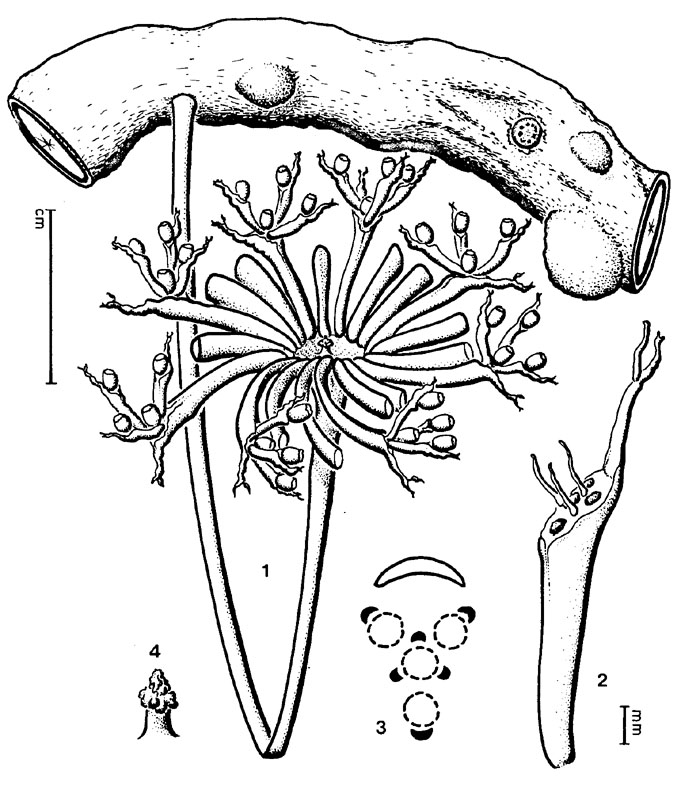
A. dilatipes. v. Balgooy 547, L. - 1. lnflorescence attached to epicortical root; one scar, and three young inflorescences still within capsules are also visible. For the sake of clarity, a number of tetrads have been cut away, leaving only the base of peduncles. - 2. Tetrad enlarged, with flowers removed. The forked organ on the right is the primary bract. - 3. Diagrammatic representation of Fig. 2. The primary bract indicated by a white crescent, other bracts in black. - 4. Aborted apex of compound umbel. From Kuijt (1981).
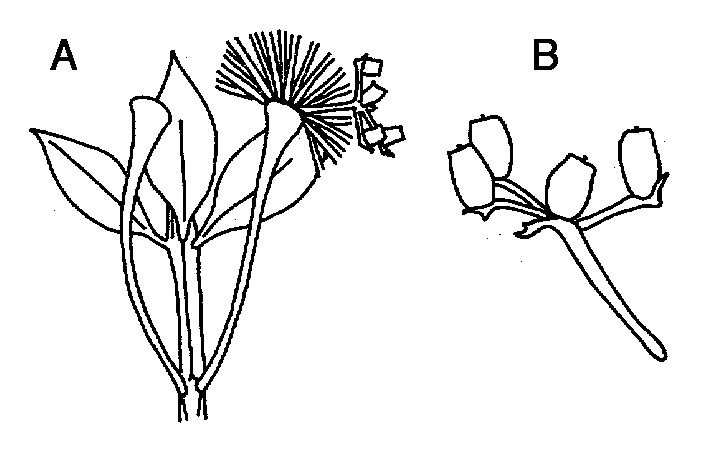
Amyema dilatipes. A - portion of plant. B - inflorescence tetrad. From Barlow (1974).
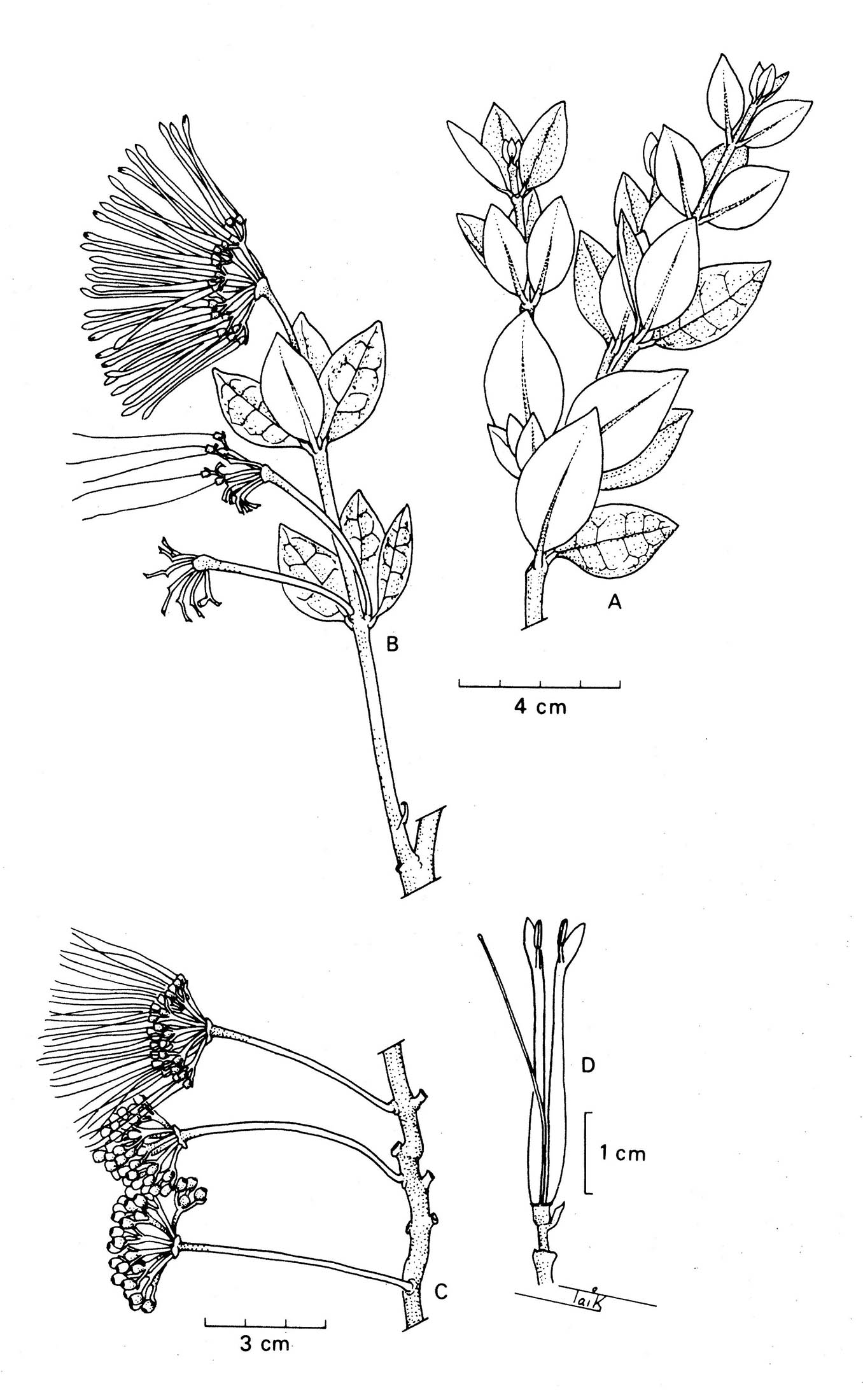
Amyema dilatipes. A - leafy twig. B - Flowering twig. C - Inflorescences. D - longitudinal section of flower. From Barlow (1981).
Photographs
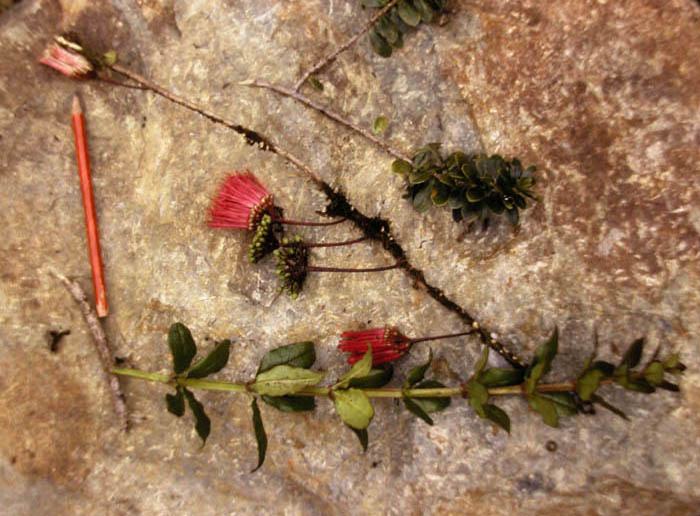
Amyema dilatipes (probably). Photo taken on Mt. Kergomia in 1971. From an unidentified slide archived at the LAE herbarium.

Amyema dilatipes (probably). Closer view of same slide as above.
Amyema dilatipes
updated 20 January 2007